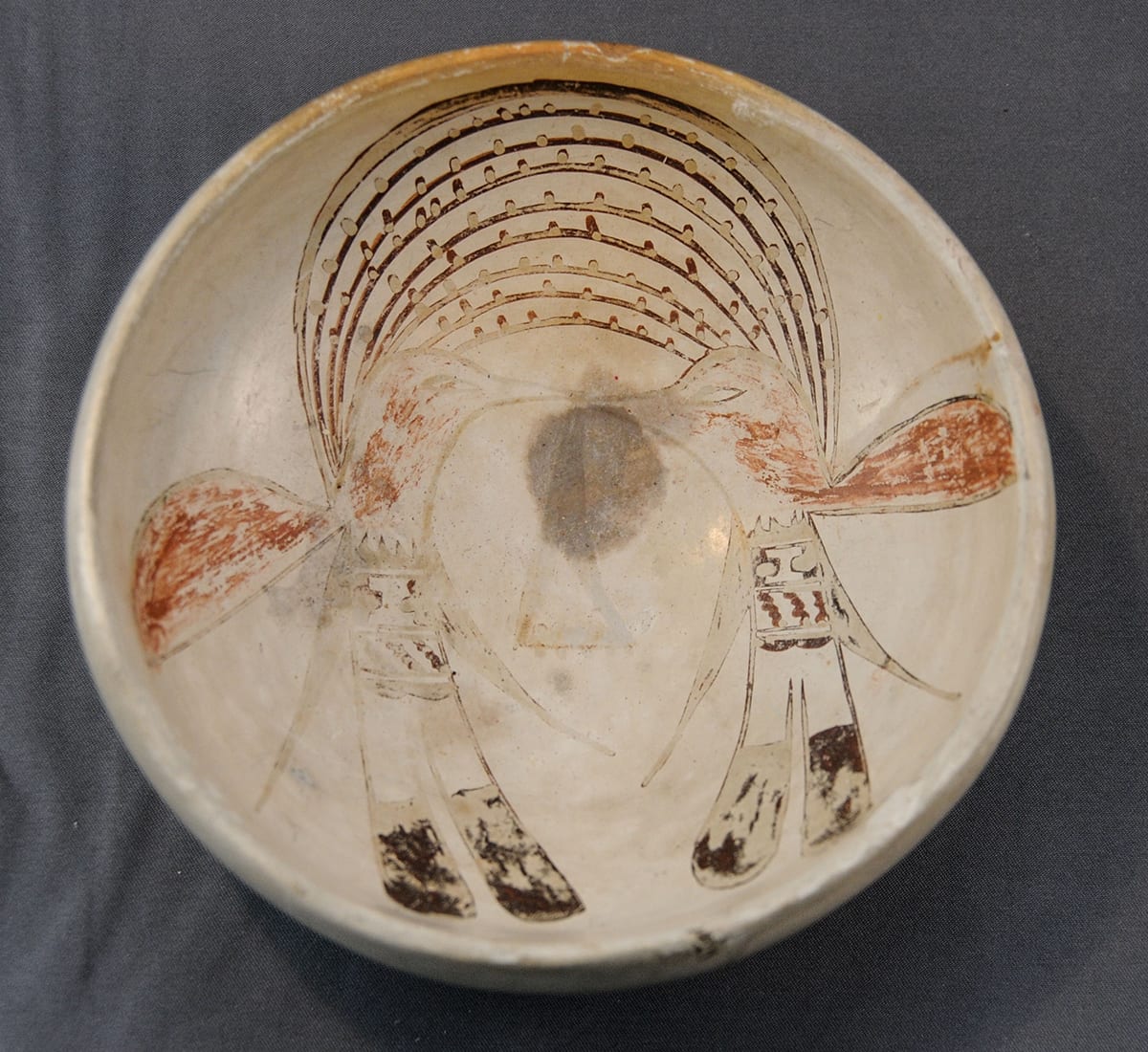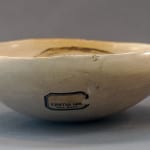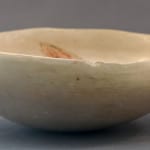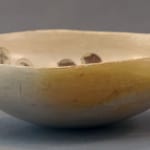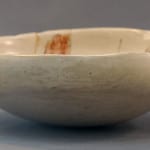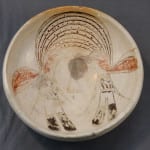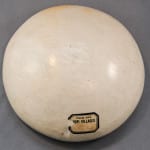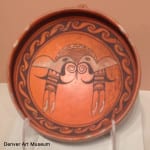This bowl is somewhat deep, has a slight rim coil, and is kaolin slipped. I showed this bowl to Ed Wade at his home in Sedona, October 13-14, 2013. Ed’s opinion is that it is a Kaolin slip over Sikyatki clay body that also fires quite white. Given the pure white color, he believes it was coal fired during the first decade of the 20th century using Kaolin slip from Coyote Springs. Coyote Springs was on the Nampeyo family ranch and supplied the finest kaolin clay in the area. Ed suspects that the potter was thus of the Corn Clan, though not Nampeyo or one of her daughters. Apparently, the kaolin deposit at Coyote Springs was exhausted during the first decade of the 20th century, thus helping Wade date this bow. As early as 1896, Nampeyo had developed a fine-textured white kaolin ship that, because it was burnished before firing, did not crackle like the traditional Polacca ship (Wade & Cooke 2012:131 and 133). This seems to have been the technique used on bowl 2013-17. About 40 years later, Paqua Naha rediscovered the fabrication of burnished kaolin slip, thus establishing a style still used her descendents. (See “White-Slipped Ware” in the Index of Categories.)
The burnished surface of kaolin slip is quite slick, resulting in the fugitive paint seen here. The design is a classic variation of the Sikyatki design Fewkes called “Man Eagle” (1973:59 and 129). In a letter of attribution for bowl 1988-01 (see the catalog entry and the letter on file), Barbara Kramer notes that Annie often used this design. There is a well-know photograph by Summer W. Matteson that I have referred to frequently in this catalog and is reproduced (among other places) in Ashton (1976:33), Kramer (1996:75) and in larger format by Wade and Cooke (2012:148). Describing this photograph, Kramer writes, “At the time of Matteson’s photograph (1895-1900?), Annie would have been in her teens and still maturing as a potter. She is pictured holding a seed jar painted with two birds, beak-to-beak at a trumpet-shaped flower. Another small jar with a similar design is on the floor in the foreground. This simple concept of double bird and flower motif was painted with variations… at later dates. I suggest that it was Annie’s design and that vessels decorated with the motif were her vessels” (Kramer 1996:168).
Although badly faded, the central trumpet flower motif referred to by Kramer is just visible on bowl 2013-17 and the flanking birds are well and delicately painted. All this would suggest Annie as a painter. Compare this bowl to another in the collection with the same design that I have high confidence was painted by Annie (2006-01). Bowl 2013-17 was painted by a much more hesitant and less-skilled hand than bowl 2006-01. On the latter bowl, the central trumpet is pointed down and is linked to an additional design element. On bowl 2013-17, the trumpet is pointed up and stands alone.
Wade correctly points out, however, that the nine-strand “rainbow” that arches across the top of the design is sloppy and would not be characteristic of Annie’s work. Indeed, the design on bowl 2013-17 seems crowded into the design area and thus does not reflect the Nampeyo family design ethic. Again, this contrasts with the layout of 2006-01 that is clearly superior. (For other renditions of the double-bird design in the collection, see Man Eagle in the Index of Categories.) The painting on 2013-17, especially the figures from the neck up, is not masterful. (The lower sections of the figures seem more carefully drawn.) Pot 2013-17 carries the Harvey “From the Hopi Villages” sticker that would indicate that Harvey did not think it was “Made by Nampeyo“(or her family). I believe that mass ordered pottery for the Harvey Co. was often quickly produced by the makers and thus was generally of lower quality of form and design than pots made directly for sale. Harvey pots were often family production-line items that might be formed by one person and perhaps painted by one or more other people. Such variance in skill is seen on bowl 2013-17, further clouding the issue of provenance.
A dark spot occurs at the center of the design on bowl 2013-17, perhaps an old oil stain of some sort.
The deep profile of the bowl and the slight rim coil suggests that Nampeyo might have formed the bowl. Kramer’s comments and the delicate painting of the central image suggest that Annie might have been the painter. The quickly painted “rainbow,” Ed Wade’s comments and the crowded layout give me pause and I will refrain from attributing the bowl or painting of 2013-17.
==========
The discussion above was written before I saw the exhibit “Nampeyo: Excellence by Name” at the Denver Art Museum (DAM) on 1/7/14. That exhibit includes a bowl with a central design very much like 2013-17. The DAM bowl is labeled as by Nampeyo (catalog #1935-417). Unlike the bowl in this collection, the DAM bowl is red-slipped and has an intricate border. The museum bowl is substantially larger than the bowl in this collection and the museum thinks it was made between 1900 and 1915, a rather wide estimate.
This collection contains two other bowls with the double-bird (“Man Eagle) motif that I believe were painted either by Nampeyo (1988-01) or by Annie (2006-01). In contrast to the bowls added in 1988 and 2006, the heads and wings on both the DAM bowl and 2013-17 reflect more of a folk art tradition. The heads and wings of the birds on these two bowls are drawn simply and as a single element and painted with a solid color. (Fugitive white on the DAM bowl, and fugitive red on the bowl in this collection.) On both bowls, the bottom edge is cut flat (as by a knife) and this edge is about perpendicular to the bodies of the birds, a trait not characteristic of other renditions of this design. Both the DAM bowl and 2013-17 have a rainbow of six to nine lines that arches between the birds. On the DAM bowl, 17 white dots decorate the upper two lines. On bowl 2013-17, about 73 dots are distributed among the arched lines.
I am persuaded that both the DAM bowl and 2013-17 were painted by the same hand. (I could not handle the DAM bowl to observe its construction.) The museum did not include much provenance on the pot label, except to say that it was donated by Reverend C. W. Douglas, apparently in 1935. I will contact the museum to see if they have information about how Douglas obtained the bowl, ideally directly from Nampeyo.
Still, given the information now available, I attribute bowl 2013-17 to Nampeyo with some chance that it was painted by Annie. I did not rewrite the original discussion of 2013-17 because I wanted to leave a paper trail documenting how difficult it is to be certain of an unsigned bowl’s provenance and that, over time, additional information might change an initial assessment.
==========

